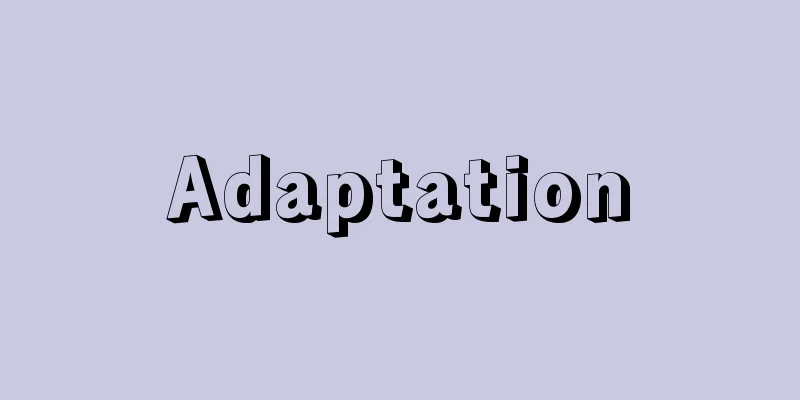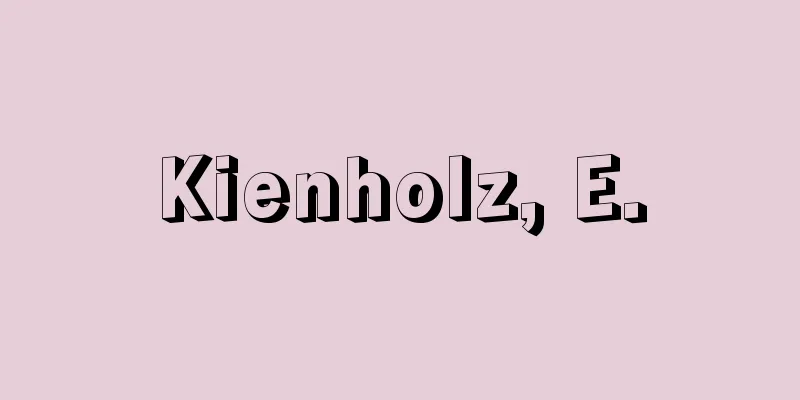Adaptation

|
Adaptation generally means adapting to changes in the environment or situation, but in the sensory and perceptual domain, it usually refers to a decrease in sensitivity to a stimulus when the same stimulus is continuously given to that stimulus (sensory adaptation). The sensory adaptation described in this section is a mechanism that is ubiquitous in all sensory systems and is the basis for the efficient functioning of the sensory system in a greatly changing environment. For example, the light intensity of sunlight and dim starlight differs by 108 to 1010 times, but humans can rely on their vision to know the surroundings throughout the day and night. The retina of the human eye has only two types of photoreceptor cells with different sensitivities, rods and cones (there are usually three types of cones with different tuning wavelengths), and the reason that only these two types can respond to large changes in light intensity is because each of them has a mechanism of adaptation. [Mechanism of sensory adaptation] When moving from a bright environment to a dark environment, you cannot see anything immediately afterwards, but after a while you start to sense the dim light and gradually begin to see your surroundings. This phenomenon occurs when the sensitivity of the visual system increases as the light intensity in the environment decreases, and is called dark adaptation. Note that dark adaptation being an increase in the sensitivity of the visual system may contradict the above explanation that adaptation is a decrease in sensitivity, but this is not inconsistent if you consider dark adaptation to be a decrease in sensitivity to darkness (making it harder to sense darkness). A curve plotting the threshold of a light spot at the same position on the retina against the time elapsed since entering a dark environment is called a dark adaptation curve. Figure 342 shows the outline of a dark adaptation curve when a light spot is presented at a position slightly shifted from the fixation point. As time passes, the threshold decreases, and the sensitivity reaches its maximum after about 30 minutes. A notable feature of this dark adaptation curve is the appearance of a bending point (Kohlrausch kink) after about 8 to 10 minutes. Before this bending point, color vision is possible for light spots near the threshold, but after this point, color is not perceived (Hecht, S., Haig, C., & Chase, AM, 1937). In other words, the curve before the bending point reflects the properties of the cones, which are the two types of light-sensitive cells in the retina that are the basis of photopic vision and color vision, and the curve after the bending point reflects the properties of the rods, which are the basis of scotopic vision. Cones adapt quickly to the dark, but their sensitivity only increases to a certain extent, and after about 10 minutes there is no change in sensitivity. In contrast, rods adapt slowly to the dark, but over time their sensitivity increases to a level where they can detect much weaker light than cones can. Because both rods and cones are present at the location on the retina where the light point is projected (the peripheral area of the fovea), the curve initially reflects the characteristics of the cones, which adapt quickly, and then later the dark adaptation of the rods becomes apparent, causing their sensitivity to increase even further. The inflection point is the intersection of the dark adaptation curves for rods and cones. The physiological mechanism of dark adaptation is based on the decomposition and resynthesis of pigments contained in light-receptor cells. For example, each rod contains about 10 million pigments called rhodopsin, which is decomposed into opsin and retinal when it absorbs a photon of light. The decomposition of rhodopsin triggers the activation of the rod, but once decomposed, the pigment cannot be involved in a new activation process until it is resynthesized by the action of enzymes. In bright light, most rhodopsin is decomposed, i.e., saturated, so the sensitivity of the rods is low. However, after a certain amount of time has passed in a dark environment, the amount of rhodopsin that remains resynthesized gradually increases, and the sensitivity of the rods increases. The time required for pigment resynthesis is significantly different between rhodopsin (30 minutes) and cone pigment (6 minutes), which is related to the difference in dark adaptation time characteristics between rods and cones. In contrast to dark adaptation, when moving from a dark environment to a bright environment (e.g., when passing through a long tunnel), you feel a moment of glare and cannot see your surroundings, but you can see your surroundings again soon. This phenomenon is called light adaptation. Light adaptation is a phenomenon in which the sensitivity of the visual system decreases by the reverse mechanism of dark adaptation. Light adaptation progresses more rapidly than dark adaptation, because the decomposition of pigments occurs instantly, unlike their resynthesis. It is known that vision also adapts to various other visual features, such as color, motion, and tilt. It is believed that the mechanisms of cells at the retinal receptor level play a major role in adaptation to brightness, but the involvement of higher-level cells has been suggested for other adaptations. Sensory adaptation is a ubiquitous mechanism not only in vision but in all sensory systems, and is thought to be deeply involved in perceptual constancy and grasping behavior (tactile adaptation). [Adaptation level (AL)] Sensory adaptation can also be seen as a change in the standard of perception. In dark adaptation and light adaptation, the standard luminance is updated according to the luminance of the surroundings, and the change from that is perceived as subjective brightness. Habituation is a phenomenon similar to adaptation in that it causes a change in the standard of perception. While sensory adaptation is a very short-term sensory change that occurs immediately after continuous exposure to a certain stimulus, habituation is a sensory change that usually occurs in response to a stimulus that has been exposed intermittently for a long period of time, such as becoming insensitive to the smell of one's own home. Habituation also differs from sensory adaptation in that it continues for a long period of time and does not affect discrimination sensitivity, and it is thought to be related to learning. Helson, H. (1948, 1959, 1964) believed that the perception of a stimulus and the accompanying judgment occur within a frame of reference determined by the intensity of other stimuli presented in the same situation and previous perceptual experiences. He proposed the adaptation level theory, which states that the adaptation level (the stimulus level perceived as neutral or balanced) is derived based on the frame of reference, and specific stimuli are perceived and judged based on the magnitude relationship and difference between this and the intensity of the given stimulus. Please note that in this theory, the word adaptation refers to a broad adaptation process that includes not only sensory adaptation but also habituation. The adaptation level theory can be used to explain various perceptual phenomena such as perceptual constancy and contrast. For example, it is known that in an experiment requiring judgment of stimulus intensity, if a stimulus that does not directly require judgment (anchor stimulus) is inserted into the stimulus sequence, the judgment of the subsequent stimulus changes (anchoring effect). This is explained by the change in the adaptation level caused by the anchor stimulus. The adaptation level theory is now being applied to various fields other than perception, such as social attitudes, social behavior, and emotional responses. → Threshold → Sensation → Vision → Perception [Reiko Yakushigami] (Palmer, S. E., 1999) Figure Schematic diagram of dark adaptation curve Latest Sources Psychology Encyclopedia Latest Psychology Encyclopedia About Information |
|
順応とは,一般には環境や状況の変化に適応することをいうが,感覚・知覚領域では通常,同じ刺激を持続的に与えられることによってその刺激に対する感度が低下すること(感覚的順応sensory adaptation)を指す。本項で述べる感覚的順応はすべての感覚系に遍在するしくみであり,環境が大きく変化するもとで感覚系が効率よく働く基盤となっている。たとえば,太陽光と暗い星明かりとでは光強度は108~1010倍ほども違うが,人間は昼夜を通して,視覚を頼りに周囲の様子を知ることができる。人間の眼の網膜には,感度の異なる光受容細胞として桿体rodと錐体coneの2種類しかなく(錐体には通常,同調波長の異なる3種類がある),この2種類のみで大きな光強度変化に対応できているのは,それぞれが順応というしくみを備えているからにほかならない。 【感覚的順応のメカニズム】 明るい環境から暗い環境に移動すると直後は何も見えないが,しばらくすると薄暗い光を感じるようになり,徐々に周囲の様子が見えてくる。この現象は環境の光強度の低下に伴って視覚系の感度が向上することによるもので,暗順応dark adaptationとよばれる。なお,暗順応が視覚系の感度向上であるというのは,順応を感度低下とした前述の説明と矛盾するかもしれないが,これは暗順応を暗さに対する感度が低下する(暗いと感じにくくなる)ことととらえると矛盾しない。 網膜上の同じ位置における光点の閾値を,暗い環境に入ってからの経過時間に対してプロットした曲線は,暗順応曲線とよばれる。342ページ図は,注視点から少しずれた位置に光点を呈示した際の暗順応曲線の概形を示す。時間が経過するにつれ閾値が下がり,約30分後には感度が最大に達する。この暗順応曲線の特記すべき特徴は,8分から10分ほど経過した時点で屈曲点(コールラウシュの屈曲点Kohlrausch kink)が現われることである。この屈曲点以前では閾値付近の光点に対して色覚があるが,以後では色は感じられない(Hecht,S.,Haig,C.,& Chase,A.M.,1937)。すなわち,屈曲点以前の曲線は網膜に存在する2種類の光感受細胞のうち明所視および色覚の基盤となる錐体の性質を反映しており,後の曲線は暗所視の基盤となる桿体の性質を反映している。錐体の暗順応は速いが,感度はある程度までしか上昇せず,10分ほどで感度変化が生じなくなる。これに対して桿体の暗順応は遅いが,時間をかけて,錐体よりも格段に弱い光でも感知できるレベルまで感度が上昇する。光点が投射されている網膜上の位置(中心窩の周辺部)には桿体と錐体の両方が存在するため,初めは暗順応の速い錐体の特徴が曲線に反映され,遅れて桿体の暗順応が顕在化して感度が一段と向上する。屈曲点は,桿体と錐体それぞれに依拠する暗順応曲線の交点というわけである。 暗順応の生理学的メカニズムは,光感受細胞に含まれる色素の分解と再合成に基づいている。たとえば,桿体一つには約1000万個のロドプシンという色素が含まれており,ロドプシンは光量子を吸収するとオプシンとレチナールに分解される。ロドプシンの分解が引き金となって桿体の活性化が起こるが,一度分解された色素は酵素の働きにより再合成されるまで,新たな活性化プロセスにかかわることができない。明るい光のもとではほとんどのロドプシンが分解されている状態,すなわち飽和状態となっているため桿体の感度は低い。ところが暗い環境に入ってある程度の時間が経過すると,徐々に再合成された状態を保つロドプシンの量が増え,桿体の感度が上がるというしくみである。色素の再合成にかかる時間はロドプシンで30分,錐体の色素で6分と大きく異なっており,このことが桿体と錐体の暗順応時間特性の違いにかかわっている。 暗順応の状況とは反対に,暗い環境から明るい環境に移動すると(例:長いトンネルを抜けた時),一瞬まぶしく感じて周囲が見えないが,すぐに周囲が見えるようになる。この現象は明順応light adaptationとよばれる。明順応は,暗順応の逆のメカニズムによって視覚系の感度が低下する現象である。明順応は,暗順応に比べて急速に進むが,これは色素の分解が再合成とは違って即時に起こることによる。 視覚に関してはほかにも色や運動,傾きなど,さまざまな視覚的特徴への順応が生じることが知られている。明るさの順応では,網膜の受容器レベルの細胞の機構が大きな役割を果たすと考えられるが,他の順応にはより高次の細胞の関与が示唆されている。感覚的順応は視覚だけでなくすべての感覚系に遍在するしくみであり,知覚の恒常性や,把握行動(触覚の順応)にも深くかかわっていると考えられている。 【順応水準adaptation level(AL)】 感覚的順応は,知覚の基準の変化としてとらえることもできる。暗順応・明順応でいえば,基準となる輝度が周囲の輝度に従って更新され,そこからの変化量を主観的な明るさとして知覚するというものである。知覚の基準の変化を生じさせるという点で順応に似ているのが,馴化habituationという現象である。感覚的順応がある刺激に持続的にさらされた直後に生じるごく短時間の感覚変化であるのに対して,馴化は通常断続的に長期間さらされた刺激に対して生じる感覚の変化であり,たとえば自分の家の匂いに鈍感になることなどが挙げられる。馴化は長期にわたって持続する点や,識別感度に影響が見られないなどの点でも感覚的順応とは異なっており,学習がかかわっていると考えられている。 ヘルソンHelson,H.(1948,1959,1964)は,刺激の知覚やそれに伴う判断は,同じ状況で呈示される他の刺激の強度やそれまでの知覚経験によって規定される準拠枠frame of referenceの内側で生じると考えた。そして,準拠枠に基づいて順応水準(中性,もしくは平衡状態として知覚される刺激レベル)が導かれ,これと与えられた刺激の強度との大小関係および差異の大きさに基づいて,具体的な刺激の知覚および判断が行なわれるという順応水準説adaptation level theoryを提唱した。なお,この説において,順応ということばは,感覚的順応だけでなく馴化などを含んだ広義の適応過程を意味することに注意してほしい。順応水準説を用いると,知覚の恒常性や対比などさまざまな知覚現象を説明することができる。たとえば,刺激強度についての判断を求める実験において,刺激系列中に直接判断を求めない刺激(係留刺激anchor stimulus)を挿入すると,後続の刺激についての判断が変わることが知られている(係留効果anchoring effect)。これは係留刺激によって順応水準が変化したことによると説明される。順応水準説は,現在では社会的態度や社会的行動,情動反応など,知覚以外のさまざまな分野にも適用されている。 →閾 →感覚 →視覚 →知覚 〔薬師神 玲子〕 (Palmer, S. E., 1999)"> 図 暗順応曲線の模式図 出典 最新 心理学事典最新 心理学事典について 情報 |
<<: Spring nightingale song - Shunnouden
Recommend
Octadecamolybdodiphosphate
...The sodium salt Na 3 [PMo 12 O 40 ]・10H 2 O fo...
Minamiashigara [city] - Minamiashigara
A city in western Kanagawa Prefecture. It was inco...
Dashwood, F.
...They met in an abandoned monastery and are sai...
Lagotis takedana (English spelling) Lagotistakedana
… [Kei Yamazaki]. … *Some of the terminology that...
Anite - Anite
...Mica that contains divalent cations such as Ca...
Otomo Yoshimune
Year of death: July 19, 1605 (September 2, 1605) Y...
Cross-country race
Also called a cross-country race. A long-distance ...
Patriotic History Forest
This was the journal of the Aikoku-sha (the nation...
Al-Jabartī, `Abd al-Raḥmān ibn Ḥasan
Born: 1753. Cairo [died]1825/1826. Cairo Egyptian ...
artificial climbing
...the anchor is generally a piton (a metal nail ...
Goban Tadanobu - Goban Tadanobu
[Noun] A general term for the joruri and kabuki pl...
Kline, F.
...Originally, it was derived from Pollock, who w...
Cor Caroli
Alpha 2 of Canes Venatici. Its unusual Latin name,...
Sphagnum gracilis - Sphagnum gracilis
...Because the plant body of Sphagnum has excelle...
smolnitza
...is a general term for dark clayey soils found ...









